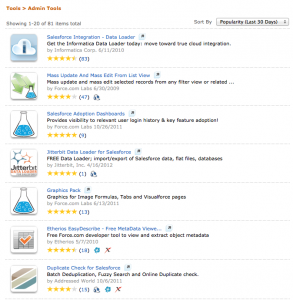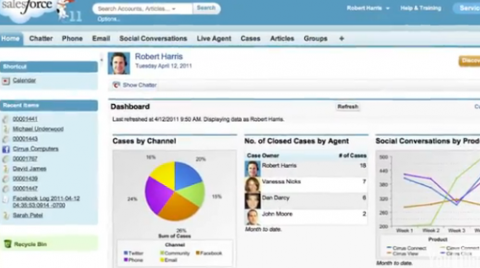When Salesforce acquired cloud-application platform Heroku in December 2010, it brought the latter’s CEO, Byron Sebastian, into the fold as an executive vice president. Salesforce has long harbored a Platform-as-a-Service (PaaS) initiative, highlighted by its cloud-based
Force.com application-development hub. Pairing that with Heroku, which gives hardcore developers the ability to deploy and scale an app (as well as manage traffic and other tasks), expanded the customer groups beneath the collective Salesforce umbrella. The move initially confused some outside analysts, who wondered just how well Heroku would mesh with Salesforce’s other assets. “Its fit into the portfolio and strategy isn’t yet clear,” Forrester analyst John Rymer wrote in a May 2011
corporate blog posting. “The PaaS market’s immaturity is also evident in the relatively low scores registered by many of the vendors in our Wave analyses.” [caption id="attachment_486" align="alignleft" width="180" caption="Salesforce EVP Byron Sebastian"]

[/caption] But Sebastian, who still serves as general manager of Heroku (now a subsidiary) in addition to his Salesforce role, argues that the business cloud and PaaS have only matured over the past year. “There’s still a lot of work that needs to be done, but I would say there’s been a shift in the conversation I’ve seen,” he explained during a recent interview. “There’s been a shift from people saying, ‘Should I be using the cloud?’ to ‘I know I need to, tell me where I’m getting started.’” Despite that change in attitude, he added, FUD—that’s “Fear, Uncertainty and Doubt,” for anyone not up-to-date on their abbreviations—still dampens some customers’ interest in adopting cloud solutions for their business. In his view, typical concerns include “the whole debate over public cloud versus private cloud, and a lot of debate and confusion over Platform as a Service (PaaS) and so on.” In Salesforce’s definition of PaaS, the server is abstracted away from the developer. “You don’t have to think about deploying, patching, or versioning the server; there are huge benefits that come with that,” Sebastian said. “Platform as a Service is not renting an application server to you by the hour; it’s about not dealing with servers at all.” [caption id="attachment_327" align="alignright" width="315" caption="Force.com Admin Tools"]

[/caption] In other words, developers have the ability to create, test, and deploy applications without the traditional issues associated with on-premise infrastructure. Salesforce isn’t shy about touting the supposed benefits of such a model. Indeed, CEO Marc Benioff, seems to take great delight in tweaking rivals’ cloud offerings in general. During the Gartner Symposium/ITxpo 2010 in October 2010, for example, he referred to Oracle’s Exalogic Elastic Compute Cloud (which allows institutions to create their own self-contained cloud platform) as “just another server.” Sebastian seems to take a more nuanced view. “Our CEO has called private cloud the ‘false cloud,’” he said. “But that doesn’t mean it doesn’t have value in terms of what the vendors are talking about: virtualization with self-service tools, for compute and storage and so on.” Nonetheless, he remains adamant about Salesforce’s model as the correct one for the emerging paradigm. Cloud, he said, “should be building this next generation of apps instead of forklifting these old legacy platforms into the cloud to save a few bucks.” Salesforce itself has been “more aggressive about going to market with that message, and what we’ve really seen as people adopt cloud platforms.” If PaaS is maturing as a developer option, though, it also means that other companies are entering the space in a significant way—and not only big players such as Microsoft, but also a variety of small PaaS vendors hungry for their own slice of the market. That could make 2012 a very interesting year for PaaS as a whole.
Images: Salesforce.com  [/caption] But Sebastian, who still serves as general manager of Heroku (now a subsidiary) in addition to his Salesforce role, argues that the business cloud and PaaS have only matured over the past year. “There’s still a lot of work that needs to be done, but I would say there’s been a shift in the conversation I’ve seen,” he explained during a recent interview. “There’s been a shift from people saying, ‘Should I be using the cloud?’ to ‘I know I need to, tell me where I’m getting started.’” Despite that change in attitude, he added, FUD—that’s “Fear, Uncertainty and Doubt,” for anyone not up-to-date on their abbreviations—still dampens some customers’ interest in adopting cloud solutions for their business. In his view, typical concerns include “the whole debate over public cloud versus private cloud, and a lot of debate and confusion over Platform as a Service (PaaS) and so on.” In Salesforce’s definition of PaaS, the server is abstracted away from the developer. “You don’t have to think about deploying, patching, or versioning the server; there are huge benefits that come with that,” Sebastian said. “Platform as a Service is not renting an application server to you by the hour; it’s about not dealing with servers at all.” [caption id="attachment_327" align="alignright" width="315" caption="Force.com Admin Tools"]
[/caption] But Sebastian, who still serves as general manager of Heroku (now a subsidiary) in addition to his Salesforce role, argues that the business cloud and PaaS have only matured over the past year. “There’s still a lot of work that needs to be done, but I would say there’s been a shift in the conversation I’ve seen,” he explained during a recent interview. “There’s been a shift from people saying, ‘Should I be using the cloud?’ to ‘I know I need to, tell me where I’m getting started.’” Despite that change in attitude, he added, FUD—that’s “Fear, Uncertainty and Doubt,” for anyone not up-to-date on their abbreviations—still dampens some customers’ interest in adopting cloud solutions for their business. In his view, typical concerns include “the whole debate over public cloud versus private cloud, and a lot of debate and confusion over Platform as a Service (PaaS) and so on.” In Salesforce’s definition of PaaS, the server is abstracted away from the developer. “You don’t have to think about deploying, patching, or versioning the server; there are huge benefits that come with that,” Sebastian said. “Platform as a Service is not renting an application server to you by the hour; it’s about not dealing with servers at all.” [caption id="attachment_327" align="alignright" width="315" caption="Force.com Admin Tools"] [/caption] In other words, developers have the ability to create, test, and deploy applications without the traditional issues associated with on-premise infrastructure. Salesforce isn’t shy about touting the supposed benefits of such a model. Indeed, CEO Marc Benioff, seems to take great delight in tweaking rivals’ cloud offerings in general. During the Gartner Symposium/ITxpo 2010 in October 2010, for example, he referred to Oracle’s Exalogic Elastic Compute Cloud (which allows institutions to create their own self-contained cloud platform) as “just another server.” Sebastian seems to take a more nuanced view. “Our CEO has called private cloud the ‘false cloud,’” he said. “But that doesn’t mean it doesn’t have value in terms of what the vendors are talking about: virtualization with self-service tools, for compute and storage and so on.” Nonetheless, he remains adamant about Salesforce’s model as the correct one for the emerging paradigm. Cloud, he said, “should be building this next generation of apps instead of forklifting these old legacy platforms into the cloud to save a few bucks.” Salesforce itself has been “more aggressive about going to market with that message, and what we’ve really seen as people adopt cloud platforms.” If PaaS is maturing as a developer option, though, it also means that other companies are entering the space in a significant way—and not only big players such as Microsoft, but also a variety of small PaaS vendors hungry for their own slice of the market. That could make 2012 a very interesting year for PaaS as a whole. Images: Salesforce.com
[/caption] In other words, developers have the ability to create, test, and deploy applications without the traditional issues associated with on-premise infrastructure. Salesforce isn’t shy about touting the supposed benefits of such a model. Indeed, CEO Marc Benioff, seems to take great delight in tweaking rivals’ cloud offerings in general. During the Gartner Symposium/ITxpo 2010 in October 2010, for example, he referred to Oracle’s Exalogic Elastic Compute Cloud (which allows institutions to create their own self-contained cloud platform) as “just another server.” Sebastian seems to take a more nuanced view. “Our CEO has called private cloud the ‘false cloud,’” he said. “But that doesn’t mean it doesn’t have value in terms of what the vendors are talking about: virtualization with self-service tools, for compute and storage and so on.” Nonetheless, he remains adamant about Salesforce’s model as the correct one for the emerging paradigm. Cloud, he said, “should be building this next generation of apps instead of forklifting these old legacy platforms into the cloud to save a few bucks.” Salesforce itself has been “more aggressive about going to market with that message, and what we’ve really seen as people adopt cloud platforms.” If PaaS is maturing as a developer option, though, it also means that other companies are entering the space in a significant way—and not only big players such as Microsoft, but also a variety of small PaaS vendors hungry for their own slice of the market. That could make 2012 a very interesting year for PaaS as a whole. Images: Salesforce.com 
